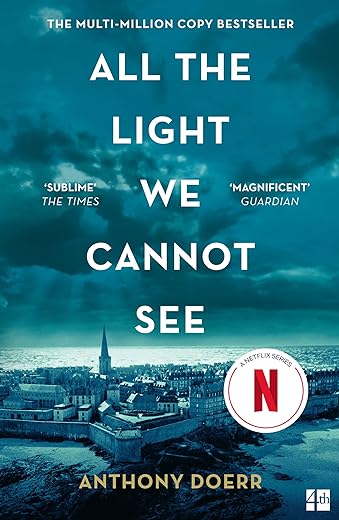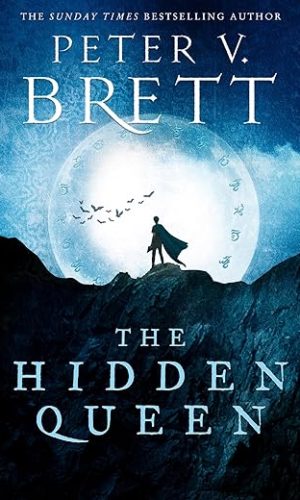All the Light We Cannot See: The Breathtaking World Wide Bestseller
£4.70
WINNER OF THE 2015 PULITZER PRIZE FOR FICTION
NATIONAL BOOK AWARD FINALIST
NEW YORK TIMES BESTSELLER
WINNER OF THE CARNEGIE MEDAL FOR FICTION
A beautiful, stunningly ambitious novel about a blind French girl and a German boy whose paths collide in occupied France as both try to survive the devastation of World War II
Marie-Laure has been blind since the age of six. Her father builds a perfect miniature of their Paris neighbourhood so she can memorize it by touch and navigate her way home. But when the Nazis invade, father and daughter flee with a dangerous secret.
Werner is a German orphan, destined to labour in the same mine that claimed his father’s life, until he discovers a knack for engineering. His talent wins him a place at a brutal military academy, but his way out of obscurity is built on suffering.
At the same time, far away in a walled city by the sea, an old man discovers new worlds without ever setting foot outside his home. But all around him, impending danger closes in.
Doerr’s combination of soaring imagination and meticulous observation is electric. As Europe is engulfed by war and lives collide unpredictably, ‘All The Light We Cannot See’ is a captivating and devastating elegy for innocence.
Read more










by Radek
“What mazes there are in this world. The branches of trees, the filigree of roots, the matrix of crystals, the streets her father recreated in his models… None more complicated than the human brain, Etienne would say, what may be the most complex object in existence; one wet kilogram within which spin universes.”
I’m a sucker for beautiful writing and this is a very beautifully written novel. Doerr always has full imaginative command of his detail and, even if occasionally he feeds too much protein into his sentences, is thus able to evoke his images searingly and poignantly. The novel is a visual delight which is an especially brilliant achievement when you consider he’s often writing about blindness. Doerr’s poetic sentence writing often transfigures the familiar, allowing us to see the natural world afresh. His prose strips us of our own blindness to the beauty in the commonplace. The natural world pervades this novel like a kind of scripture. The goodies are aligned to the natural world; the baddies see it as little more than resources for furthering ambition. This being one of the many fairy tale motifs the novel dramatises. Because it can be read as a fairy tale. There’s a magical stone in the custodianship of Marie Laure’s father, a kind of Wizard (Etienne’s brother who transmits stories over the radio which Werner and his sister listen to as children) and a very clear unwavering distinction between the good guys and the baddies with few grey areas. The innocents are pure. The corrupted are beyond help.
All the Light tells the story of Marie Laure who is blind (To shut your eyes is to guess nothing of blindness. Beneath your world of skies and faces and buildings exists a rawer and older world, a place where surface planes disintegrate and sounds ribbon in shoals through the air) and lives in Paris with her father (an idealised character in keeping with the fairy tale subtext of this novel), a locksmith and keeper of the keys at the Muséum National d’Histoire Naturelle. There, hidden in its vaults for the past 200 years, is an accursed gem, a greyish-blue sea diamond with a red hue at its centre: the Sea of Flame. When war comes Marie Laure and her father will become guardians of this stone. The other central character is Werner. Werner and his sister Jutta are orphans in the German mining town of Zollverein, near Essen in the Ruhr valley, heartland of the Nazi war industry. Werner has a gift of mending things and is especially attracted to radios. At night he and Jutta listen to an enigmatic French man telling stories for children over the radio – “a voice on the radio offering a loom on which to spin his dreams.”
As straightforward storytelling this novel is ravishing. I liked the short chapters and the flashing back and forwards in time. It reminded me of David Mitchell in its disregard for the perimeters between literary and commercial fiction. Doerr, like Mitchell, romps back and forth between the two camps with great poise and ease.
I’m not quite sure what Dave Eggers means when he says Doerr “sets a new standard for what storytelling can do” because there’s nothing groundbreaking about this novel. Like I said it’s straightforward brilliant storytelling. On one occasion Doerr uses a cheap trick, introducing a new POV to crank up tension (an informer who lives near Marie Laure) and then discarding the POV for the rest of the novel but on the whole the artistry of this novel was spellbinding. One of the novel’s themes is guardianship, executed especially well with Werner’s protective but ultimately impotent feelings towards the dreamy Frederick at the bullyboy Nazi college, but shown as a constant facet of the novel’s every relationship. Everyone is guarding some precinct, some stone or calling of the heart. How, above all else, we are all guardians of our own flame which, in the novel, is often seen as our relation to how we use our time and best dramatised through Marie Laure’s great-uncle, the shellshocked Etienne who after WW1 became agoraphobic and never leaves his house until circumstances force him out. This idea is also expressed by Werner – “He thinks of the old broken miners he’d see in Zollverein, sitting in chairs or on crates, not moving for hours, waiting to die. To men like that, time was a surfeit, a barrel they watched slowly drain. When really, he thinks, it’s a glowing puddle you carry in your hands; you should spend all your energy protecting it. Fighting for it. Working so hard not to spill one single drop.”
Transmitters/transmission is another constant theme. The diamond transmits a curse, coal transmits energy, light transmits codes and of course the radio transmits a channel through which Marie Laure and Werner first connect and establish their elective affinity. Doerr creates a world we’re all blind to, a world pulsing with invisible transmitting circuitry. So what began as a clever stroke of emotional manipulation – the positing of a blind girl at the heart of the novel – becomes a tour de force of thematic choreography.
Map-making is another theme. Etienne’s broadcasts create a map that unites Werner and Marie Laure. Marie’s father builds her a miniature scaled model of her Paris neighbourhood and then, when they move, a miniature model of Saint-Malo in order that she may feel her way through a perfect replica of her surroundings. Werner is mapping out enemy transmitters during the war. Once again Doerr is exploring the invisible grid that maps out our lives, the light we cannot see.
The bitchiness of Carmen Callil’s review in the Guardian was astonishing. Rarely do fellow writers publically ridicule each other in public. Just the opposite. There seems to be a you-pat-my-back-and-I’ll-pat-yours attitude to reviewing so you have to wonder why her review seemed so personally malicious. Often the reviews seemed to have this novel down as a brilliant page-turner but not great literature. I’ve been wondering about this. I adored reading this novel and then perhaps, a day after finishing it, felt maybe I had been somehow tricked into liking it better than it deserves. Does Doerr lack a little subtlety in his emotional manipulation of the reader? If you write a novel about a blind girl with an adoring ideal father and an orphan boy who protects his younger sister you’re obviously going to almost immediately command a great deal of sympathy for your characters. These are the innocents of fairy stories. Also the stalker von Rompel who Doerr makes no attempt to portray as anything but pantomime villain. But all these motifs belong to the fairy story aspect of this novel and within that context are managed well I think. It’s also been said Doerr doesn’t deal with Nazism very convincingly. Is that a valid criticism? The English patient is a WW2 novel and it could be said that doesn’t deal with Nazism very well either. Doesn’t prevent it from being a brilliant thought-provoking novel.
“Impossibly, the static coalesces into music. Volkheimer’s eyes open as wide as they can. Straining the blackness for every stray photon. A single piano runs up scales. Then back down. He listens to the notes and the silences between them, and then finds himself leading horses through a forest at dawn, trudging through snow behind his great-grandfather, who walks with a saw draped over his huge shoulders, the snow squeaking beneath boots and hooves, all the trees above them whispering and creaking. They reach the edge of a frozen pond, where a pine grows as tall as a cathedral. His great-grandfather goes to his knees like a penitent, fits the saw into a groove in the bark, and begins to cut.”
by Kindle Customer
A wonderful, evocative read, beautifully written.
Set in Europe during the Second World War.
Jules Verne, blindness, the sea, atrocities, brutalised boys.
I found the jumping about to different times a little confusing.
by Bubblecat1980
I looked for this having seen a trailer for the new show and feeling intrigued. I also know 9/10 times the show never does the book justice so I wanted to read the book, not watch the show. I’m so glad I found it, the writing is beautiful. The stories compelling and flow together so well. I read all the time, but I haven’t read anything as well put together as this for a very long time. Highly recommend.
by Ralph Blumenau
Part of this hugely inventive novel charts, separately, in very short chapters and in the urgent Historic Present, the lives of Marie-Laure LeBlanc and Werner Pfennig. The novel follows the now modish fashion, which I find very irritating, of moving backward and forward in time.
Marie-Laure, born in 1928 in Paris, became blind at the age of six. Her mother had died in childbirth; her loving father, Daniel, teaches her to “see”, using her fingers, training her memory. He is a locksmith employed at the Museum of Natural History, and his hobby is making small models, for example of the streets of their neighbourhood in Paris, which his daughter, using her fingers, can learn to navigate. She absorbs information about the world, also from Braille books, which fascinate her. The author is brilliant as describing what it is like to make some sense of the world when you are blind.
Locked securely away in the Museum of Natural History is a valuable diamond, called the Sea of Flames, to which is attached a legend that anyone who owns it will not die, but that disasters will strike his family or friends. People half believe the story.
When the war starts, the contents of the Museum are packed up and sent out of Paris; and then, in 1940, she and her father join the stream of civilians moving south. Her father has taken the diamond with him. And eventually they finish up in German-occupied St Malo, in Brittany, in the house of the father’s uncle, Étienne, a strange man, disturbed by memories of the First World War, and house-bound for many years. He knows all about radios, and has been broadcasting scientific educational programmes. Daniel makes a model of St Malo for his daughter. Inside it, he hides the diamond. In 1941 he receives a telegram summoning him back to Paris. He leaves Marie-Laure in the care of his uncle and the uncle’s housekeeper. He has been denounced for measuring buildings oin St Malo, and, on the way to Paris, he is arrested and deported to Germany. When he does not return, Marie-Laure is bewildered and devastated.
Very reluctantly, Étienne is drawn into the Resistance, which sends him code numbers. He then transmits them to the Allies.
Von Rumpel, a gemologist in the German military, whose job it was to record confiscated jewels, has heard of the diamond and is determined to track it down. He has a special personal interest in it since he is suffering from cancer. Somehow, (rather improbably), in 1944, he tracks the diamond down to St Malo and is sure that it is concealed in the model of Étienne’s house, if he can only find that model. He arrives in St Malo in August, two months after D-Day, while the town in after heavy Allied bombardment from the air and from the sea. He cannot find the model of the house because Marie-Laure keeps it on her person and is hiding behind a false wall.
Werner, born in 1927, lives in an orphanage at Zollverein, a mining town near Essen. His father had been killed in the mines. His hobby is making and repairing radio sets and inventing gadgets. From Étienne’s broadcasts, and then from books, he absorbs scientific information which fascinates him. (There is a lot about physics, geology and natural history in the book – Doerr writes columns about scientific books for the Boston Globe.) Werner’s skill as a radio repairer gets him noticed by a high-up in the Nazi party, who saves him from going down the pit when he would reach 16, and instead gets the 14 year-old sent to a school of engineering in Saxony, where the boys are also given a brutal military training. A sadistic commandant devises ways of weeding out the weakest of the boys. He has them hunted down by the others, who are ordered to savage them. Most do it with zest. Repeatedly the commandant has them victimize a gentle friend of Werner’s, finally with terrible results. Werner is appalled, but helpless.
But he is a great success as a student: he contributes to finding a way to track down the location of radio transmitters. Then, in 1942, still only sixteen, he is sent into the army which has need of his skills. Initially he is sent to the Eastern Front, where his group neutralize many Russian transmitters. But this scarcely affects the German retreat, and Werner finds himself in Vienna. There he receives a summons to St Malo: the Germans guess that a transmitter there is sending out messages, and Werner is the man to locate the site of the transmitter. So he, too, ends up in St Malo. He picks up the transmission – and recognizes the voice of Étienne from the broadcasts he had listened to as a child. He locates the house, and sees Marie-Laure emerge from it.
So there they are, Werner, Marie-Laure and von Rumpel in the midst of the apocalyptic bombardment. Each of them, for one reason or another, is desperate, hungry, thirsty and dirty.
I have perhaps already given away rather more of the book than some readers would like – but if I described the dénouement, I would indeed be guilty of spoilers. Suffice it to say that Werner and Marie-Laure meet, and not as enemies. But they spent less than a day together. There is no happy ending for the two of them.
And what exactly happened to the little model house and the diamond? It scarcely becomes clearer in the penultimate part of the book, set in 1974, thirty years after the siege of St Malo. As for the last part, set in 2014, I can’t see the point of that at all.
At 544 pages, the book has its longueurs, especially in the febrile thoughts and memories of Marie-Laure, Werner and von Rumpel. I think there are some loose ends; but on the whole it was a good read.
by the-time-being
I approached this book with some trepidation thinking it might be just a little twee, however right from the first page I was hooked. A truly breathtaking, cinematic work that keeps you entranced and engaged right until the end.
by Catrin purse
The quality of the book.
by TALFIE1
I was mesmerized by the beautiful story telling. My heart broke and repaired in equal measure.
One of the most amazing stories I have read in a long time.
by Andy Murcott
The story resonates so well with what’s happening around the world at the moment. It illustrates the futility of war and its awful wastefulness. Its beautifully written and captures ones imagination.